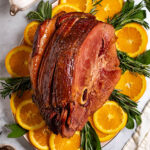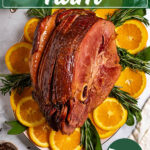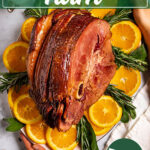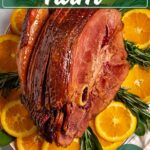Description
This honey glazed ham will be the center piece of your Thanksgiving, Christmas, or Easter table! The honey glaze creates a beautiful caramelized ham that is savory, sweet, and salty. Plus, it’s so easy to make!
Ingredients
Honey glaze
- 1/4 cup dark brown sugar
- zest of 1 large orange
- 1/2 cup honey
- 1/4 cup apricot jam, or preserves
- 3 tablespoon Dijon mustard
- 1/2 to 3/4 teaspoon ground cloves
- 3 tablespoons unsalted butter
- 1/4 to 1/2 orange, freshly squeezed
Ham
- 8 to 11 pound spiral ham (see notes)
Instructions
- Prepare the ham – If you ham is frozen, be sure to defrost it completely a day or two in advance from when you plan to cook it. 2 hours prior to cooking, remove the ham from the fridge and allow it to come to room temp. This is important as it helps the ham to cook evenly.
- Preheat the oven – preheat the oven to 325 degrees Fahrenheit.
- Prepare the baking dish – Line a 9×13 baking dish, or roasting pan well with foil. I like using a baking dish that has handles so that it’s easier to lift the heavy ham out of the oven. You will want to use several pieces of foil. At this time, you can unwrap the room temp ham, and drain any of it’s liquid. Transfer it to the prepared baking dish, cut side down. Set aside.
- Make the honey glaze – To a heavy bottomed 2 qt sauce pot, add the dark brown sugar, then zest the orange right into the brown sugar – use your fingers to rub the orange zest and the brown sugar together until the orange is fragrant. Add the honey, apricot jam/preserves, ground cloves, and unsalted butter to the sauce pot. Place the pot on medium high heat, and use a whisk to stir occasionally until everything is melted, and well combined. Allow the mixture to come to a simmer, and allow it to simmer, whisking frequently, for 2 minutes. Immediately remove from the heat. The consistency should cling to the back of a spoon, but be pourable. NOTE: reserve the orange that was zested for later.
- Add the first layer of glaze to the ham – Use a silicone pastry brush to brush about 1/3 of the glaze all over the ham. Then, insert an oven safe, instant read thermometer into the thickest part of the ham – make sure it’s not touching the pan, or the ham bone. Set the thermometer so that the timer will go off once the ham reaches 100 degrees Fahrenheit.
- First bake – Tightly cover the entire baking dish with foil – you will need several pieces. Place the ham in the oven to bake for about 1 1/2 hours to 2 hours, or until the internal temp reaches 100 degrees Fahrenheit. It usually takes about 10 to 11 minutes per pound.
- Second bake & second glaze – Once the ham has reached 100 degrees, remove the ham from the oven and increase the oven temp to be 425 degrees Fahrenheit – keep the ham covered until the oven comes to temp. In the mean time, gently reheat your glaze on the stove top so that it becomes runny again. At this squeeze in 1/4 to 1/2 of that reserved orange. This does two things: 1. it loosens the glaze a bit, and 2. it adds a lovely fresh orange flavor. Once the oven has reached 425 degrees Fahrenheit, remove the foil from the ham, and brush on anther 1/3 of the glaze over the entire ham. Change the setting on your oven safe meat thermometer to beep at 130 degrees Fahrenheit (remember, the ham is fully cooked, we are just heating it up). Place the ham into the oven, uncovered, and cook 10 minutes.
- Final bake & final glaze – After the 10 minutes, remove the ham from the oven and brush another 1/3 of the glaze onto the ham – being sure to get into all the crevices. Bake uncovered, for another 10 minutes – or until the internal temp of the ham reaches 130 degrees Fahrenheit – and the ham looks shiny, and the glaze has browned nicely. Note: if using a smaller ham, you might not use all of the glaze.
- Rest – Transfer the ham to a cutting board, and tent it with foil (I re-use the foil that was previously covering the ham) – allow the ham to rest for 30 minutes. This helps to prevent the juices from running out of the ham – creating a juicier ham.
- Reserve the cooking juices (optional step) – if you want, you can serve the cooking juices with the ham, for drizzling – it’s really good. To do this, transfer the cooking juices from the pan to a fat separator – allow the fat to rise to the top. Then, carefully poor the juice into a serving dish, leaving behind as much of the fat as possible. Serve the juice warm.
- Serve – After the ham has rested for 30 minutes, you can use a chef’s knife to cut off semi pre sliced pieces of ham and transfer them to a serving dish. Serve immediately. If you want to add a nice garnish, you can add orange slices, and fresh rosemary/sage around the ham. Other options could be sliced apples, or wedges of pomegranate. I know these aren’t in the recipe, but they are an easy, and classic way to dress up the platter of a ham for the Holidays.
Notes
Spiral ham – You want to make sure to get a high quality spiral ham. They are fully cooked, and usually smoked. Spiral ham just means that the ham is partially pre cut into slices for you – making the final carving process easier. You could do a whole ham that is not pre cut, but the spiral hams are easier to find, and easier to work with in the end. An 8 pound spiral ham should cost you around $50. Anything less than that, and you are probably not getting a good quality ham.
Tips to avoid a dry ham – 1) use an oven safe meat thermometer, so that you know the exact temp of the ham. 2) don’t allow the ham to cook over 130 degrees Fahrenheit. Residual heat, after the ham is pulled from the oven, will continue to rise by 5 degrees. 3) Allow the ham to rest for the full 30 minutes, before cutting into the meat. This allows the juices to re-distribute back into the ham, rather than running out. Note: a spiral ham is fully cooked, we are simply re-heating it, and giving it a yummy glaze. So, there is no need to heat it up to 160 degrees, like you would a raw piece of ham. 130 degrees will ensure the ham is warmed all the way through, without drying it out.
Leftovers – I recommend cutting the ham while it’s still warm, if possible, it’s easiest to get all of the meat off this way. Once it’s cut, allow the leftover ham to cool completely before transferring it to an air tight container. Store the ham in the fridge for up to 5 to 7 days. Use the ham in sandwiches, soups, eggs, omelets, casseroles, or just re-heat it as is – the sky is the limit. The ham will freeze nicely for 3 to 6 months.
Ham bone – If you want, you can save the ham bone to make ham broth with for soups. If you don’t plan to make the broth right away, then you can freeze it for up to 6 to 8 months. You can use the same method as my instant pot chicken broth recipe here to make the ham broth.
Recipe is adapted from baked ham from Natasha’s kitchen








